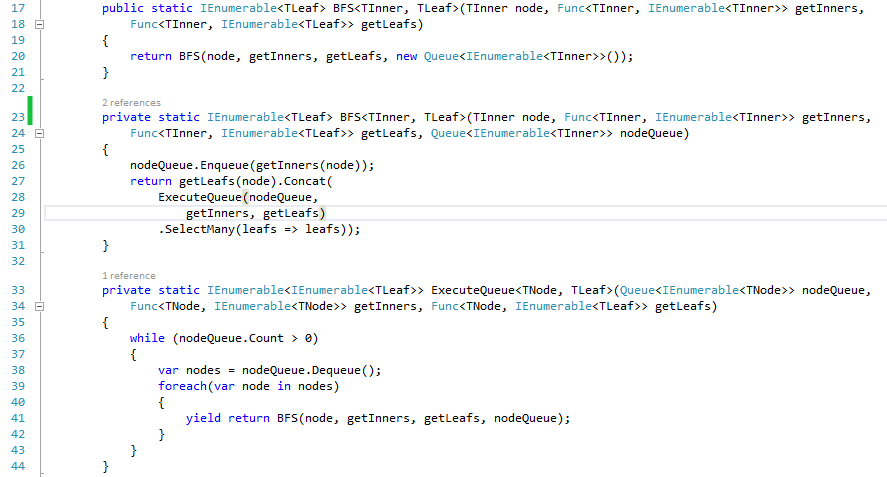Archives
-
LINQ to Graph
As promised in my previous, I now provides some details about an example I gave during my talk at SoCal Code Camp titled “LINQ to Objects A-Z”. In this blog, I will discuss LINQ to Graph.
LINQ to object has a large number of functions to query IEnumerable<T>. What if we are dealing with a hierarchy? It turns out LINQ can flatten one-level-down hierarchies with one of the SelectMany methods. For deeper hierarchies, we need to do either the depth-first-search (DFS) or the breath-first-search (BFS). In this post, I will provide generic implementations of BFS and DFS. These functions return an IEnumerable<T> that can subsequently processed with LINQ.
With DFS, we need to recursively place exposed nodes on a stack and search each node until nothing left on the stack. With BFS, we use a queue instead of a stack to store unsearched nodes. The implementation of DFS is relatively simple as recursive function calls already provide a stack implicitly. The following code snippets show the DFS implementation.
The DFS function accept the three arguments. The first argument is the starting node. The second argument getInners is a lambda function that returns the child inner nodes of a parent node. The third argument is a lambda function that returns the leaf nodes of a parent node.
The following code snippets demonstrate using DFS to search a direction for files recursively. We pass the path of the starting directory as the first argument. We use Directory.EnumerateDirectories to implement the getInners function and use Directory.EnumerateFiles to implement the getLeafs function.
The implementation of BFS is longer. We need to implement a queue explicitly. Two helper functions are defined to help managing the queue. The BFS function can be used in place of DFS in the recursive problem; only the order of the outputs will change.
The source code of this blog could be found at http://skylinq.codeplex.com. In future blogs, I will continue discussing application of LINQ in combinatorial problems.
-
Is it time for cloud-based ASP.NET IDE? (round 2)
8 months ago, I asked whether it is time for cloud-based ASP.NET IDE. I have long been dreaming of being able to create web application on the spot while talking to users. I was able to do that 20 years ago with VB3. Today, the closest thing I can do with web application is with a CMS like Orchard. To work on a live website, we need an editor that is accessing the live site. We also need a tool to indicate the link between the html in the browser and the code that generate the html.
A lot has happened in the past 8 months. For the cloud based editor, first I saw Scott Hanselman’s blog about Microsoft’s own cloud editor. Then we found this editor to appear in Visual Studio Online.
For the tools that link html with source code, I first saw the very impressive shape tracing tool in Orchard. Then we saw the browser link and remote debugging feature in Visual Studio 2013.
So whether the IDE itself is in the cloud or not, the new VS2013 features together with the Azure feature of deploying directly from a repository brings up ever close to being able to work on a live web application in front of a customer.
-
Gave a talk at SoCal Code Camp at USC today titled “Linq to Objects A-Z”
I gave a talk at SoCal Code Camp on Linq to Objects. With careful categorization of Linq functions, I was able to cover the entire set of Linq functions in only 35 minutes. I was able to spend the rest time on demos.
In my first demo, I show I was able to write a top 20 URL type of query using 4 lines of library code and 9 line of Linq code without tools like Log Parser. I also demonstrated that I only need to change 2 lines of code from querying a single log file to a whole directory of log files. It would be as simple to run the query against multiple servers in parallel.
In my second demo, I discussed how to turn into graph depth-first-search (DFS) and breath-first-search (BFS) in the a Linq queryable problem. The class LingToGraph contains the only DFS and BFS code I ever have to write; the rest could be done the the lambda passed to the DFS or BFS calls.
In future blogs, I will provide more details explanation of code.
Links:
Link to Powerpoint slides.
![image[2] image[2]](https://aspblogs.z22.web.core.windows.net/lichen/Media/image2_0D6BC28B.png)
![image[5] image[5]](https://aspblogs.z22.web.core.windows.net/lichen/Media/image5_7CF3518F.png)
